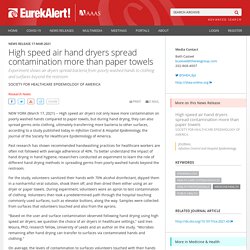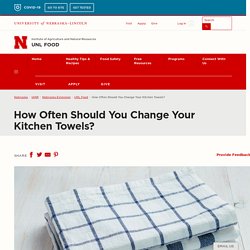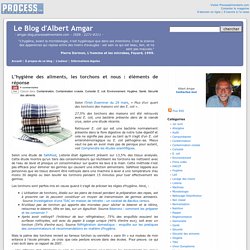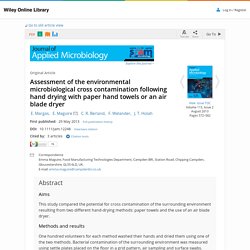

EUREKALERT 09/06/18 Kitchen towels could contribute to the growth of potential pathogens that cause food poisoning. June 9, 2018 - Atlanta, GA - Researchers from the University of Mauritius have shown that factors such as family size, type of diet, multi-usage of towels, among other factors, impact the growth of pathogens on kitchen towels, potentially causing food poisoning.

The research is presented at ASM Microbe, the annual meeting of the American Society for Microbiology, held from June 7th to June 11th in Atlanta, Georgia. "Our study demonstrates that the family composition and hygienic practices in the kitchen affected the microbial load of kitchen towels," said Dr. EUREKALERT 17/03/21 High speed air hand dryers spread contamination more than paper towels. NEW YORK (March 17, 2021) -- High speed air dryers not only leave more contamination on poorly washed hands compared to paper towels, but during hand drying, they can also spread germs onto clothing, ultimately transferring more bacteria to other surfaces, according to a study published today in Infection Control & Hospital Epidemiology, the journal of the Society for Healthcare Epidemiology of America.

Past research has shown recommended handwashing practices for healthcare workers are often not followed with average adherence of 40%. To better understand the impact of hand drying in hand hygiene, researchers conducted an experiment to learn the role of different hand drying methods in spreading germs from poorly washed hands beyond the restroom. For the study, volunteers sanitized their hands with 70% alcohol disinfectant, dipped them in a nonharmful viral solution, shook them off, and then dried them either using an air dryer or paper towels. Ines Moura, Duncan Ewin, Mark Wilcox. UNIVERSITY OF NEBRASKA LINCOLN - How Often Should You Change Your Kitchen Towels? Kitchen towels and dishcloths should probably be changed more often than you think.

Harmful bacteria can be transferred to a dishcloth when wiping unclean kitchen surfaces. The bacteria are then spread all over the kitchen when that same towel is used to wipe counters, the kitchen table, and the top of the stove. How often should you change your kitchen towels and dishcloths? The USDA recommends kitchen towels should be changed frequently and a common recommendation is to change them daily. However, it does depend on how often the towel is used and what it is used for in the kitchen.
NIH_GOV - 1968 - A study of bacterial contaminants of cloth and paper towels. BLOG D ALBERG AMGAR 29/03/12 L’hygiène des aliments, les torchons et nous : éléments de réponse. Selon l’Irish Examiner du 29 mars, « Plus d’un quart des torchons des maisons ont des E. coli ». 27,5% des torchons des maisons ont été retrouvés avec E. coli, une bactérie présente dans de la viande crue, selon une étude récente.

Retrouver E. coli qui est une bactérie normalement présente dans la flore digestive de notre tube digestif et cela ne signifie pas pour au.tant qu’il s’agit d’un E. coli entérohémorragique ou E. coli pathogène. -aa. Mieux vaut ne pas en avoir mais pas de panique pour autant, voir Comprendre les études scientifiques. Selon une étude de Safefood, Listeria était également présent sur 13,5% des tissus analysés. Les torchons sont parfois mis en cause quand il s’agit de préciser les règles d’hygiène. L’utilisation de torchons, étalés sur les plans de travail pendant la préparation des repas, est à proscrire car ils peuvent constituer un moyen de transmission de germes ambiants.
Articles similaires. BLOG D ALBERG AMGAR 29/08/14 De la présence de bactéries dans les torchons de cuisine. Résumé.

La présence fréquente de bactéries entériques dans les éponges et les torchons de cuisine suggère qu’elles peuvent jouer un rôle dans le transfert de contamination des aliments, des ustensiles et des mains par des pathogènes d’origine alimentaire. J Appl Microbiol. 2013 Aug;115(2):572-82. Assessment of the environmental microbiological cross contamination following hand drying with paper hand towels or an air blade dryer. Air and surface contamination – settle plates The settle plates which were used to evaluate total viable counts were divided to three groups: controls (exposed before the start of the trial for 1 h to check the background count), long-time exposure plates (left opened during the complete 1 h trial) and short-time exposure plates (replaced approx. every 15 min stages during the trial; four stages in total).

Control and long-time exposure plates had the same sampling time; therefore, they provide an indication of the contamination level before and after each trial and also point out how the contamination differed between the two drying methods. Plates from the four 15 min stages (stage 1, stage 2, stage 3 and stage 4) were compared with each other to investigate the micro-organism build-up in the room environment during one hour of use. The average settle plate results from controls and long-term exposure plates during each day for each method are expressed as box plots in Fig. 3.
ANSES - FEV 2013 - Hygiène domestique. FOOD PROTECTION - 2014 - Bacterial Occurrence in Kitchen Hand Towels.